As one of the original 13 colonies, Virginia is a state with a rich history. It’s also rich in biodiversity and is home to more than 20 unique turtle species! Below, we’ll take an in-depth look at 10 of the most amazing turtles in Virginia, as well as where you can find them, how to identify them, and much more.
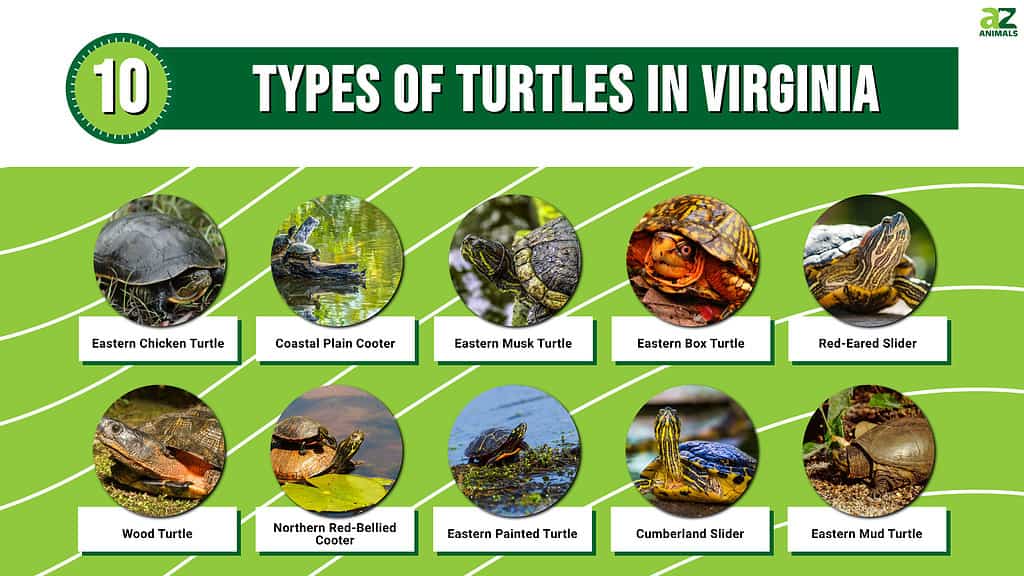
1. Eastern Chicken Turtle (Deirochelys reticularia reticularia)
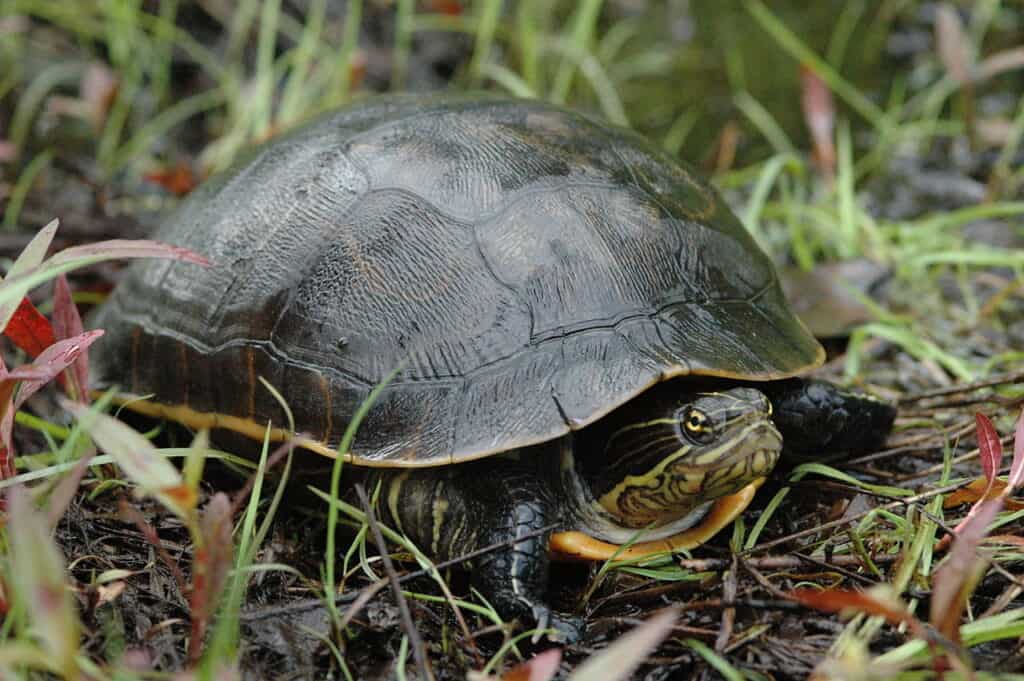
Known for its flexible neck, the eastern chicken turtle is rare in Virginia.
©Virginia State Parks staff / CC BY 2.0 – License
The eastern chicken turtle is one of three chicken turtle subspecies, with the other two being the Florida and western varieties. It’s the most widespread and abundant of all three subspecies and has a very wide geographic range that spans most of the American Southeast.
One of the eastern chicken turtle’s most prominent traits is its long, flexible neck for its small size. It’s only around 4 to 9 inches long on average, with females being longer than males, but males have longer and thicker tails. Its carapace is typically greenish-brown with a very thin light brown or yellowish webbing or net-like pattern and a yellow border around its edges. The underside of the shell, the plastron, is yellowish and sometimes has darker reddish-brown markings.
The eastern chicken turtle mainly lives in southeastern states like Georgia, Louisiana, Mississippi, and Alabama. Unfortunately, it is endangered and very rare in Virginia, but it can sometimes be found in the eastern corner of the state. As a semi-aquatic species, it can live in a variety of freshwater habitats, but it prefers shallow, slow-moving rivers and streams.
2. Coastal Plain Cooter (Pseudemys floridana)

Female coastal plain cooters are larger than males.
©iStock.com/Sunshower Shots
Also known as the Florida cooter, the coastal plain cooter primarily lives along the southeast United States’ coastal plain area.
This species is fairly large as far as freshwater turtles go at 9 to 13 inches long on average. Females are longer and larger than males. Its carapace varies from dark olive green to dark brown and has a thin yellow webbing pattern. Notably, the rear end of the carapace is somewhat pointed and has serrated edges along its sides. Its plastron is pale yellow to orange, and its skin is dark greenish-brown with yellow striping.
Coastal plain cooters can be found from southeast Virginia down to the Florida panhandle region and as far west as southern Alabama. It can thrive in various still or slow-moving freshwater habitats like lakes, ponds, and streams with soft, muddy, or sandy bottoms and lots of aquatic vegetation.
3. Eastern Musk Turtle (Sternotherus odoratus)

Eastern musk turtles release a foul odor as their defense mechanism.
©iStock.com/AntonyMoran
The eastern musk turtle is commonly known as the “stinkpot” turtle for the foul odor it can release from scent glands along the sides of its shell. It’s a smelly defense mechanism, but it works!
Aside from its scent glands, the eastern musk turtle has few defenses. It averages just 4 to 5 inches in length and has a long neck and large feet for its size. Its rounded, dome-shaped carapace is light to dark greyish brown and sometimes has small, mottled dark brown or black markings. Its skin is also dark greyish brown with thin yellow stripes along the sides of its head and neck. The turtle’s plastron is also very small for its size and is usually a solid yellowish or off-white color.
You can find this unique turtle throughout most of Virginia–though it’s probably best to admire it from a safe distance! Its geographic range covers most of the eastern half of the United States from Florida up through Maine and parts of southern Canada. It is highly aquatic and prefers shallow, slow-moving freshwater habitats with muddy bottoms.
4. Eastern Box Turtle (Terrapene carolina carolina)
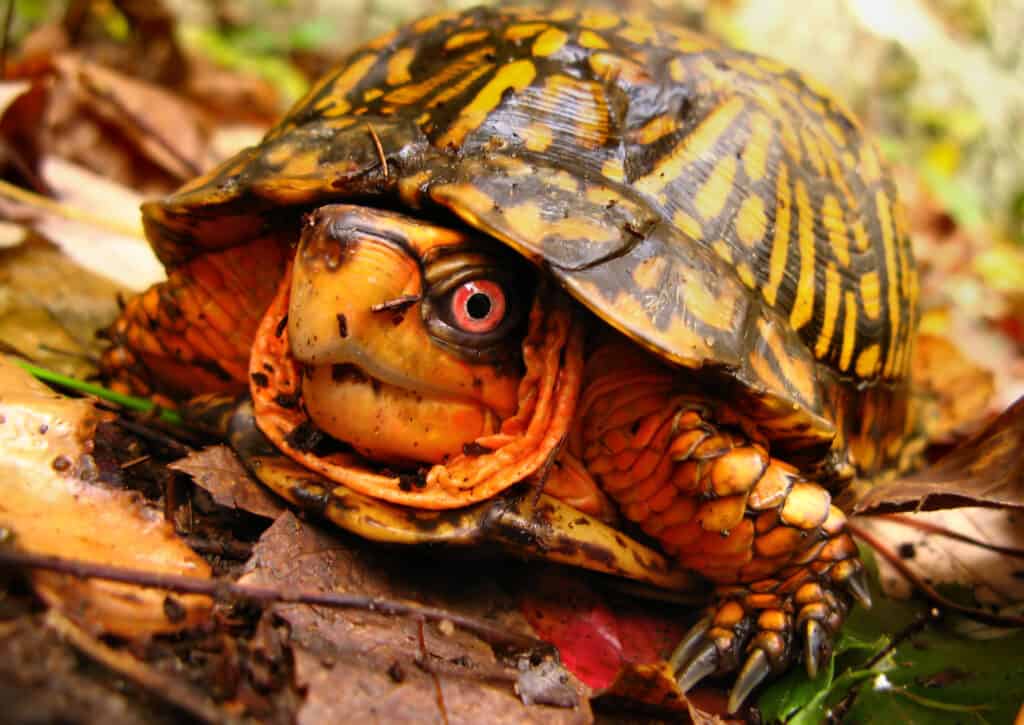
Despite being terrestrial, eastern box turtles live near water.
©outdoorsports44/Shutterstock.com
The eastern box turtle is one of three common box turtle subspecies (the other two are the Gulf Coast and Florida varieties). Like all box turtles, it ages very slowly and can live for over 100 years!
Typically, eastern box turtles are roughly 4 to 6 inches long. They have a tall, rounded, dome-shaped carapace that varies in color, but it’s usually dark brown with yellow, orange, or reddish-mottled markings. Its skin color also varies but is usually similarly dark brown with yellow to red markings throughout, particularly around its limbs and neck. Males have red eyes, while females’ eyes are usually brown.
The eastern box turtle is mostly terrestrial, but it always stays close to water. It prefers open, wooded habitats close to freshwater lakes, ponds, and streams. It lives throughout most of the eastern US from northern Florida up through the New England area as well as most of Virginia.
5. Red-Eared Slider (Trachemys scripta elegans)

Red-eared sliders live mainly in northern and eastern Virginia.
©effective stock photos/Shutterstock.com
The red-eared slider is well-known for its hardy nature and popularity in the exotic pet trade. In the wild, they are quite social animals and often bask in large groups atop logs and rocks.
On average, the typical red-eared slider is around 5 to 8 inches long. It has dark green skin with yellow striping and bright red splotches on either side of the head behind the ears. Its carapace varies in color but is usually dark green or greenish brown and sometimes has small, yellowish markings. It darkens in color with age. The turtle’s plastron is light yellowish with small, irregular green markings.
This species’ geographic range covers part of the American Midwest and much of the Southeast from the Gulf Coast area east to Florida and as far north as Michigan and Wisconsin. It mainly lives in northern and eastern Virginia and can thrive in various still, warm freshwater habitats like ponds, lakes, and slow-moving streams.
6. Wood Turtle (Glyptemys insculpta)

The wood turtle’s name comes from its rugged shell.
©Jay Ondreicka/Shutterstock.com
The wood turtle gets its name from its rugged, sculpted, somewhat flat shell that looks and feels like wood! It is closely related to the bog turtle, which is in the same genus, Glyptemys.
This unique turtle’s dark brown carapace has slightly raised, pyramid-shaped scutes with concentric ring-like markings on each individual scute. It’s roughly 5 to 8 inches long on average. The turtle’s plastron is yellowish with dark brown markings. Similarly, its skin is dark brown with a yellow or orange underside, particularly under the throat, chin, and around the limbs. Males are larger than females and have longer claws.
Wood turtles primarily live throughout most of the American Northeast from northern Virginia through Maine and southern Canada. They also can be found as far west as the Great Lakes area. Their preferred habitats are wooded forests near shallow, slow-moving, or still lakes, streams, and ponds with soft, sandy bottoms.
7. Northern Red-Bellied Cooter (Pseudemys rubriventris)
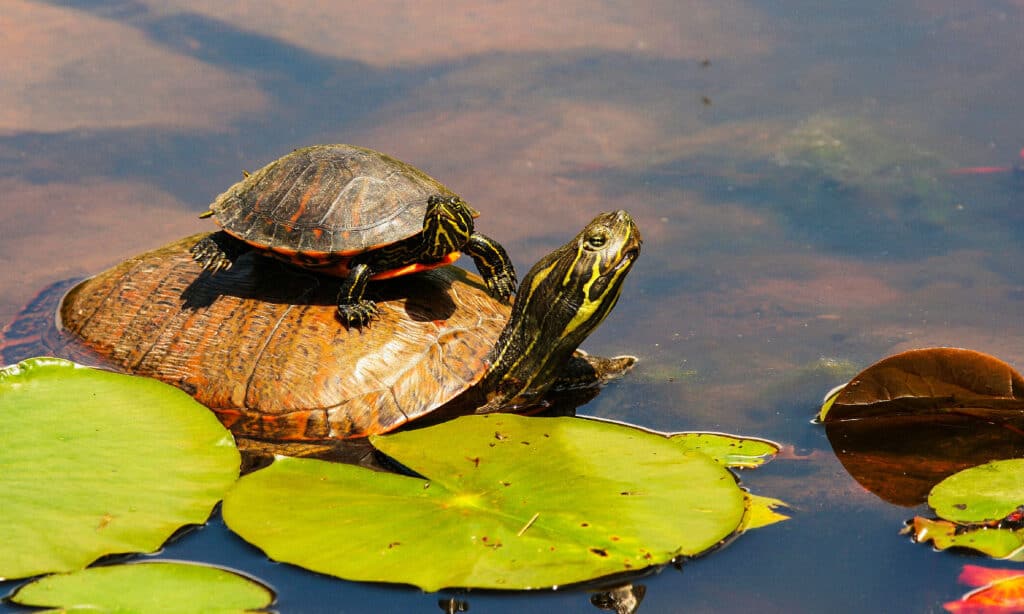
The female northern red-bellied cooter is larger than the male.
©iStock.com/DavidByronKeener
The northern red-bellied cooter is quite large for a freshwater turtle, with particularly large females sometimes reaching over 15 inches long! The species’ scientific name, rubriventris, essentially translates to “red belly.”
On average, though, most turtles of this species are 10 to 12 inches long. Females are both larger and longer than males. The turtle’s carapace is dark reddish-brown with lighter brown and dark yellow line-like markings on each scute. It has a slightly raised ridge, or keel, running down its center. The edges of the carapace are often orange or reddish, while the plastron ranges from dark yellow to bright red. Its skin is dark greenish-brown with yellow stripes along the sides of the head and limbs.
The northern red-bellied cooter’s geographic range is limited to the coastal American Northeast from northern North Carolina up through southern New York. It can be found throughout eastern and northern Virginia, where it prefers freshwater ponds, lakes, and rivers with lots of aquatic vegetation and soft, muddy or sandy bottoms.
8. Eastern Painted Turtle (Chrysemys picta picta)

Eastern painted turtles are very common in Virginia.
©iStock.com/Wildpix645
The eastern painted turtle is one of three painted turtle subspecies, with the other two being the midland and western varieties. Collectively, they are the most widespread turtle species in North America!
The typical eastern painted turtle is 5 to 7 inches long, with females being slightly longer than males. It has a dark green to almost black carapace that often has a pale stripe running down the center, red markings, and orange or reddish edges. Its plastron is pale yellowish, while its skin is dark green with yellow stripes along the head, neck, and limbs.
You can find this turtle throughout most of Virginia. It is highly aquatic and can tolerate both freshwater and brackish habitats, though it prefers still or slow-moving waters with soft muddy, or sandy bottoms. Its geographic range covers most of the US east coast from Georgia up through Maine and southern Canada. In the winter, it hibernates by burrowing in said soft mud.
9. Cumberland Slider (Trachemys scripta troostii)

The Cumberland slider has a pale yellow plastron with dark spots.
©iStock.com/Charlotte Bleijenberg
The Cumberland slider is a subspecies of the pond slider turtle. It is also known as the Troost’s turtle, as it was named after Dutch-American naturalist Gerard Troost.
Like most pond sliders, this turtle averages 5 to 8 inches long. It has an olive-green to brown carapace with yellow markings and a yellow rim. Its plastron is pale yellow with darker spots, while its skin is olive green with bold, thick yellow striping. It can be differentiated from other similar species by the yellow-to-orange stripe-like markings behind each eye.
Of all pond slider subspecies, the Cumberland slider has one of the most limited geographic ranges. It mainly lives in east Tennessee, northern Georgia, western North Carolina, and southern Virginia. It prefers freshwater habitats with muddy bottoms and abundant, easy-to-access basking spots nearby.
10. Eastern Mud Turtle (Kinosternon subrubrum subrubrum)
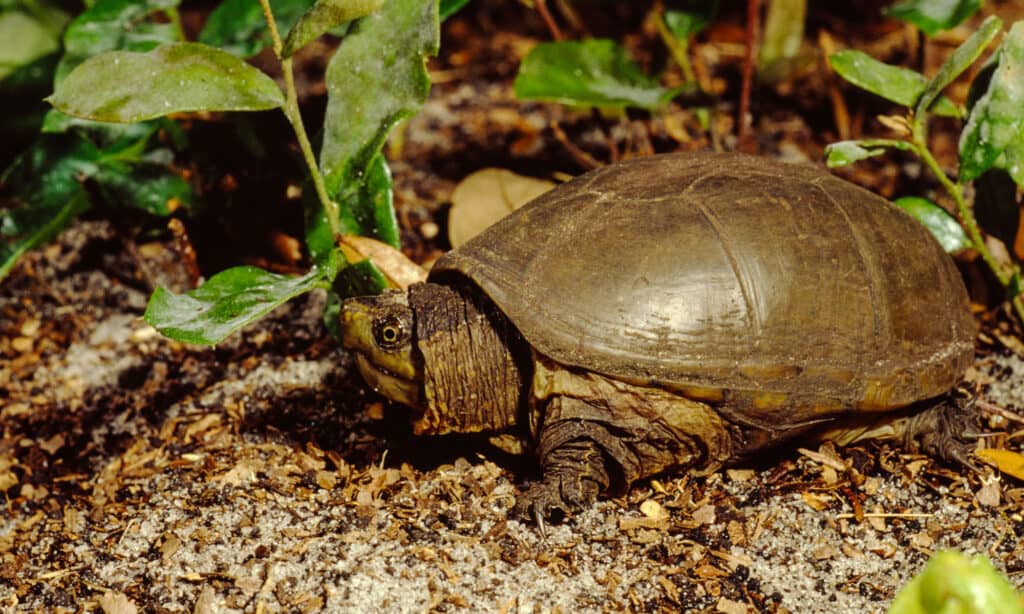
Eastern mud turtles live in freshwater ponds in eastern Virginia.
©Liz Weber/Shutterstock.com
Finally, we’ll cap off this list with the eastern mud turtle, also known as the common mud turtle. Interestingly, similar to the box turtle, its plastron has hinges! The turtle can use these hinges to tightly seal itself into its shell to protect itself from predators.
At just 3 to 4 inches long on average, the eastern mud turtle is very small. Its rounded, keel-less carapace varies in color from dark yellow to very dark brown. The turtle’s plastron is large for its size and double-hinged. Its skin is dark brown with a yellowish-grey chin and throat. Juveniles of the species have a reddish plastron, but this color fades with age.
As its name implies, eastern mud turtles live throughout eastern Virginia. The species’ geographic range covers most of the Gulf Coast area as well as the American Southeast. It can be found as far south as south Florida and as far north as southern New York! In terms of habitats, it can tolerate both freshwater and brackish water. However, it prefers freshwater ponds, lakes, and rivers with lots of vegetation–and, of course, lots of mud.
Summary of 10 Types of Turtles in Virginia
| Turtle | Scientific Name | |
|---|---|---|
| 1 | Eastern Chicken Turtle | Deirochelys reticularia reticularia |
| 2 | Coastal Plain Cooter | Pseudemys floridana |
| 3 | Eastern Musk Turtle | Sternotherus odoratus |
| 4 | Eastern Box Turtle | Terrapene carolina carolina |
| 5 | Red-Eared Slider | Trachemys scripta elegans |
| 6 | Wood Turtle | Glyptemys insculpta |
| 7 | Northern Red-Bellied Cooter | Pseudemys rubriventris |
| 8 | Eastern Painted Turtle | Chrysemys picta picta |
| 9 | Cumberland Slider | Trachemys scripta troostii |
| 10 | Eastern Mud Turtle | Kinosternon subrubrum subrubrum |
The photo featured at the top of this post is © Liz Weber/Shutterstock.com
Thank you for reading! Have some feedback for us? Contact the AZ Animals editorial team.







